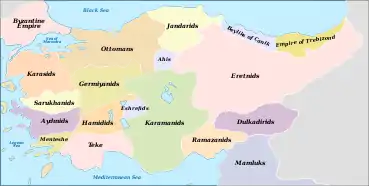Duchy
A duchy is a medieval country, territory, fief, or domain ruled by a duke or duchess, a high-ranking nobleman hierarchically second to the king or queen in European tradition. The term is used almost exclusively in Europe, where in the present day there is no sovereign duchy (i.e. with the status of a nation state) left.

The term "duke" (like the corresponding "duchy") should not be confused with the title Grand Duke (or Grand Duchy, such as the present-day Grand Duchy of Luxembourg), as there exists a significant difference of rank between the two.
In common European cultural heritage, a grand duke is the third highest monarchic rank, after emperor and king. Its synonym in many Slavic and Baltic European languages (Russian, Lithuanian, etc.) is translated as Grand Prince, whereas most Germanic and Romance European languages (English, French, Spanish, Italian etc.) use expressions corresponding to Grand Duke.[1] Unlike a duke, the sovereign grand duke is considered royalty (or in German, 'royal nobility', Königsadel). The proper form of address for a grand duke is His Royal Highness (HRH),[2] whereas for a non-royal duke in the United Kingdom it is His Grace.
In contrast to this, the rank of a duke differs from one country to the next. In Germany, for example, a duke is listed in the aristocratic hierarchy below an emperor (Kaiser), king (König), grand duke (Großherzog), and elector (Kurfürst) – in that order – whereas in Britain the duke comes third after king/queen and prince (there are no British grand dukes or electors).[3]
In all countries, there existed an important difference between "sovereign dukes" and dukes subordinate to a king or emperor. Some historic duchies were sovereign in areas that would become part of nation-states only during the modern era, such as Germany (a federal empire) and Italy (a unified kingdom). In contrast, others were subordinate districts of those kingdoms that had unified either partially or completely during the medieval era, such as France, Spain, Sicily, Naples, and the Papal States. In England, the term is used in respect of non-territorial entities.
Examples

Traditionally, a grand duchy, such as Luxembourg or Tuscany (1569–1860), was generally independent and sovereign. There were also many sovereign or semi-sovereign duchies in the de facto confederate Holy Roman Empire (961–1806) and German-speaking areas.
In France, a number of duchies existed in the medieval period including Normandy, Burgundy, Brittany, and Aquitaine.
The medieval German stem duchies (German: Stammesherzogtum, literally "tribal duchy", the official title of its ruler being Herzog or "duke") were associated with the Frankish Kingdom and corresponded with the areas of settlement of the major Germanic tribes. They formed the nuclei of the major feudal states that comprised the early era of the Holy Roman Empire of the German nation (961-1806; in German: Heiliges Römisches Reich Deutscher Nation). These were Schwaben (Swabia, mainly the present-day German state of Baden-Württemberg), Bayern (Bavaria), and Sachsen (Saxony) in pre-Carolingian times, to which Franken (Franconia, at present the northern part of the German state of Bavaria) and Lothringen (Lorraine, nowadays mostly part of France) were added in post-Carolingian times. As mentioned above, such a duke was styled Herzog (literally "the one who is leading [the troops]").
In medieval England, duchies associated with the territories of Lancashire and Cornwall were created, with certain powers and estates of land accruing to their dukes. The Duchy of Lancaster was created in 1351 but became merged with the Crown when, in 1399, Henry Bolingbroke, Duke of Lancaster, ascended the throne of England as Henry IV. Nowadays the Duchy of Lancaster always belongs to the sovereign and its revenue is the Privy Purse. The Duchy of Cornwall was created in 1337 and held successively by the Dukes of Cornwall, who were also heirs to the throne. Nowadays, the Duchy of Cornwall belongs to the sovereign's heir apparent, if there is one: it reverts to the Crown in the absence of an heir apparent, and is automatically conferred to the heir apparent upon birth. These duchies today have mostly lost any non-ceremonial political role, but generate their holders' private income. During the Wars of the Roses, the Duke of York made a successful entry into the City of York, by merely claiming no harm and that it was his right to possess "his duchy of York".[4] Any and all feudal duchies that made up the patchwork of England have since been absorbed within the Royal Family. Other than Cornwall and Lancaster, British royal dukedoms are titular and do not include land holdings. Non-royal dukedoms are associated with ducal property, but this is meant as the duke's private property, with no other feudal privileges attached.
In more recent times, territorial duchies have become rare; most dukedoms conferred in the last few centuries have been of a purely ceremonial or honorific character (see Duke). At present all independent (i.e., sovereign) duchies have disappeared.
Luxembourg, an independent and sovereign nation with a history dating back as far as the 8th century,[5] is the only remaining independent grand duchy, with the Grand Duke Henri (dynasty of Luxembourg-Nassau) as its head of state since the year 2000.
In the Middle East the concept of beylik can be seen as equivalent to duchy ("bey" being a Turkish title for the head of a house, and similar to "duke" when that person is the highest representative of the state in a principality). For example, the Ottoman Empire, first just the nomadic Kayı tribe among the Ghuzz (Oghuz Turks), settled in Bithynia on the border to the Byzantine Empire, evolved under the Sultanate of Rûm (Seljuks in Anatolia) into a border principality (Uç beyliği /margraviate). It became an independent principality after the Anatolian Seljuk state was shattered by the Mongols. Later it grew further into its own empire by conquering the nearby Anatolian beyliks, also remnants of the Sultanate of Rûm.
List of grand duchies
Current
Historical
- Grand Duchy of Baden
- Grand Duchy of Finland
- Grand Duchy of Hesse
- Grand Duchy of Lithuania
- Grand Duchy of Mecklenburg-Schwerin
- Grand Duchy of Mecklenburg-Strelitz
- Grand Duchy of Moscow (called by the Russians Grand Principality of Moscow)
- Grand Duchy of Oldenburg
- Grand Duchy of Saxe-Weimar-Eisenach
- Grand Duchy of Tuscany
List of duchies
Anatolia

Baltic States
Denmark
- Duchy of Schleswig
- Duchy of Holstein (formally part of the Holy Roman Empire)
England
France
- Duchy of Anjou
- Duchy of Aquitaine
- Duchy of Berry
- Duchy of Bourbon
- Duchy of Brittany
- Duchy of Burgundy
- Duchy of Normandy
- Duchy of Orléans
- Duchy of Lorraine
Holy Roman Empire
- Duchy of Alsace (in English also ‘Alsatia’)
- Duchy of Austria (later Archduchy of Austria, in German: Erzherzogtum Österreich)
- Duchy of Bavaria
- Duchy of Bohemia
- Duchy of Brabant
- Duchy of Bremen
- Duchy of Brunswick
- Duchy of Carinthia
- Duchy of Carniola
- Duchy of Franconia
- Duchy of Gelders
- Duchy of Holstein
- Duchy of Lauenburg
- Duchy of Limburg
- Duchy of Upper Lorraine
- Duchy of Lower Lorraine
- Duchy of Luxemburg (a Grand Duchy since 1815; see above)
- Duchy of Magdeburg
- Duchy of Mecklenburg
- Duchy of Oldenburg
- Duchy of Pomerania
- Duchy of Salzburg
- Duchy of Savoy
- Duchy of Saxe-Altenburg
- Duchy of Saxe-Coburg and Gotha
- Duchy of Saxe-Meiningen
- Duchy of Saxony
- Duchy of Styria
- Duchy of Swabia
- Duchy of Thuringia
- Duchy of Westphalia
- Duchy of Württemberg
The following duchies were part of the medieval Kingdom of Italy (not to be confused with the modern Kingdom of Italy (1860-1945)), which itself was part of the Holy Roman Empire:
- Duchy of Milan
- Duchy of Mantua
- Duchy of Sabbioneta
- Duchy of Montferrat
- Duchy of Guastalla
- Duchy of Modena and Reggio
- Duchy of Mirandola
- Duchy of Massa and Carrara
Naples
- Duchy of Acerenza
- Duchy of Apulia
- Duchy of Sora
Papal States (Holy See)
Poland
Spain
Sweden
All provinces of Sweden have the right to have a ducal coronet in their arms.[6][7] The king gives princes and princesses ducal titles of them. The current such royal duchies are:
See also
Fictional duchies
- Underland, ruled by Underbeit, on The Venture Brothers
- Duchy of Atreides from the Dune series by Frank Herbert
- Soleanna from Sonic the Hedgehog
- Duchy of Dollet (from Final Fantasy VIII)
- Grand Duchy of Jeuno (from Final Fantasy XI)
- Duchy of Grand Fenwick
- Borogravia, Quirm (from the Discworld series)
- The Six Duchies (from The Farseer Trilogy and Tawny Man Trilogy by Robin Hobb)
- Zeon (from the Mobile Suit Gundam series, also sometimes translated as a Principality, as the Japanese language does not distinguish between the two)
- Erat, Asturia, Mimbre, Wacune (from the Belgariad series)
- Crydee, Yabon, Krondor, Olasko, Rillanon, Ran, Rodez, Salador, The Sunset Isles (from the Riftwar saga)
- Kolvir, ruled by main character Prince Corwin in The Chronicles of Amber
- Freid (from The Vision of Escaflowne series)
- Cagliostro from Lupin III: The Castle of Cagliostro
- Duchy of Nuts from Adventure Time with Finn & Jake
- Duchy of Harrington from the Honorverse
- Duchy of Toussaint, from The Witcher series.
- Duchy of Serkonos, from Dishonored 2
- Duchy of Urnst, from the Dungeons & Dragons Greyhawk Campaign Setting.
- Duchy of Bewcastle [Duke of Bewcastle] from Slightly Series (esp. Slightly Dangerous) by Mary Balough
Fictional grand duchies
- The Grand Duchy of Ryn, from the early computer adventure game The Datestones of Ryn
- Grand Duchy of Jeuno (from Final Fantasy XI)
- Grand Duchy of Karameikos, from the Dungeons & Dragons Mystara Campaign Setting.
- Grand Duchy of Geoff, from the Dungeons & Dragons Greyhawk Campaign Setting.
References
- Meyers Taschenlexikon Geschichte 1982, vol. 2, p. 319.
- Meyers Taschenlexikon Geschichte 1982, vol. 1, p. 21.
- Meyers Taschenlexikon Geschichte 1982, vol. 3, p. 62.
- The Second War of the Roses
- Paul Margue, Luxemburg in Mittelalter und Neuzeit, publ. Bourg-Bourger, Luxembourg City 1974, p13
- Clara Nevéus in Ny svensk vapenbok 1992 Streiffert & Riksarkivet, Stockholm ISBN 91-7886-092-X p. 17
- Heraldiska föreningen "Heraldik är läran om vapensköldar" by Martin Trägen
External links
| Look up duchy in Wiktionary, the free dictionary. |